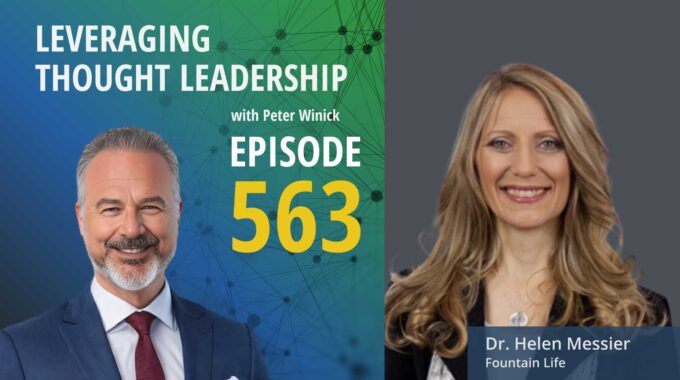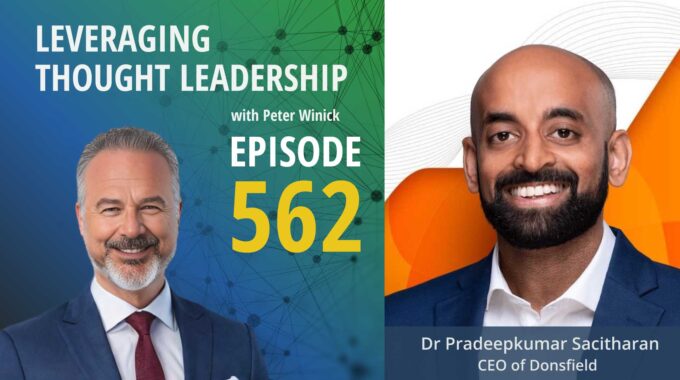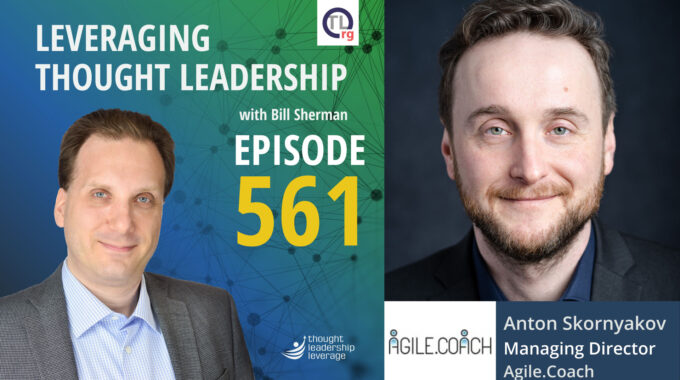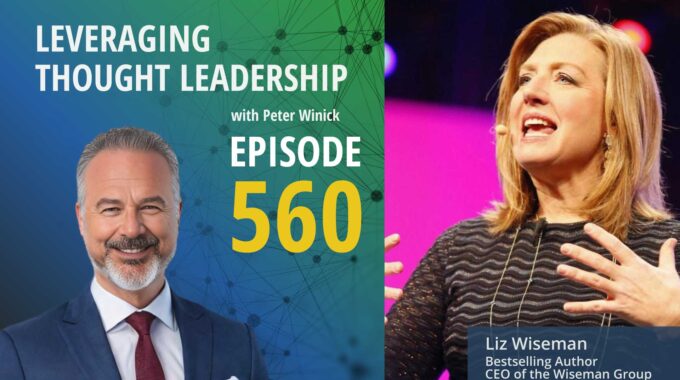Strategies for Shaping the Future of Healthcare A conversation with Dr. Helen Messier about what…
Organizational Thought Leadership Series | Joan Driggs | 218
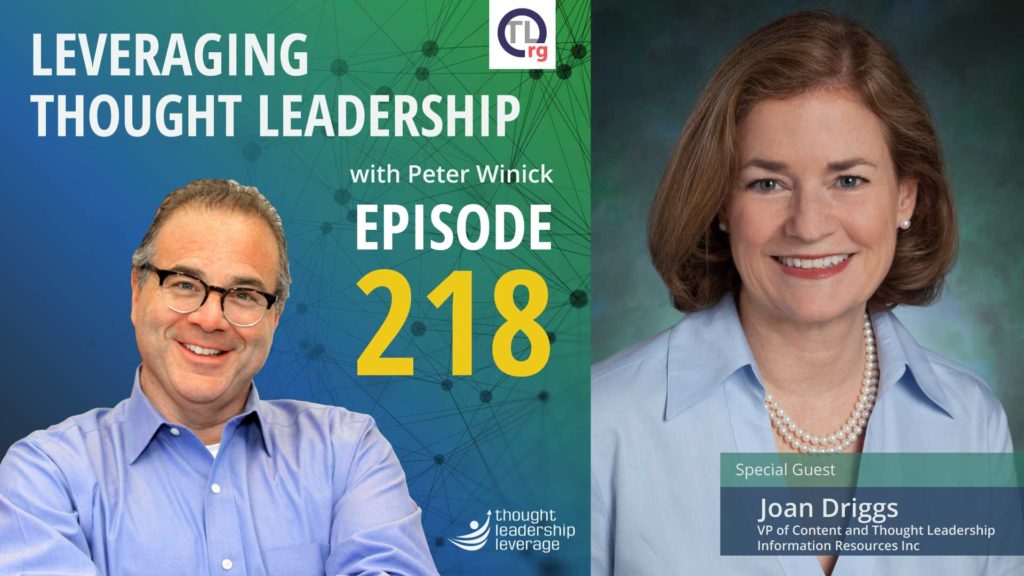
How to Do Your Best Organizational Thought Leadership in Difficult Times
An interview with Joan Driggs about organizational thought leadership at IRI.
We interviewed Joan Driggs, Vice President of Content and Thought Leadership at IRI about organizational thought leadership and changing times. How to do your best thought leadership within an organization, and what the term “organizational thought leadership” means to the folks at IRI.
Three Key Takeaways from the Interview:
- What is organizational thought leadership?
- How does organizational thought leadership help an organization get an advantage in our modern business world?
- What does it mean to make the shift into organizational thought leadership, and how can you thrive in such an environment?
Are you an accidental guru? Do you want to start transitioning from academic to thought leader? Thought Leadership Leverage can assist you with the process. Contact us and start the conversation!
Join the Organizational Thought Leadership Newsletter to learn more about expanding thought leadership within your organization! This monthly newsletter is full of practical information, advice, and ideas to help you reach your organization’s thought leadership goals.
Transcript
Peter Welcome, welcome, welcome. This is Peter Winick. I’m the founder and CEO of Thought Leadership Leverage, and you’re joining us on the podcast today, which is Leveraging Thought Leadership. This is part of our series for the organizational thought leadership, organizational thought leader. So, it’s a little bit different than what we traditionally do. We’re doing a bunch of these in the coming weeks on folks that are embedded in organizations and companies that utilize thought leadership as part of their functional role. So, with that being said today, my guest is John Driggs. Joan is the V.P. of Content and Thought Leadership at Information Resources. I’ll give you her quick bio. She attributes Curiosity is key to her 30 plus year career as a result driven market researcher, CPG trade journalist and thought leader. Let’s see what else we can put in here briefly. Like mobile. Let’s just dive in. Welcome aboard, Joan, instead of maybe spending all day reading your bio here, so you are at IRI and you are a V.P. of content and thought leadership. So, let me ask you sort of two questions. One is how do you define thought leadership and then what is a V.P. of content and thought leadership do?
Joan Driggs Well, I try. Thanks for having me, Peter. IRI is a data analytics company and we provide a lot of solutions for CPG retailers and manufacturers. You know, across a broad spectrum of solutions are some amazing stories. You know, we work with a lot of very smart people who love to hide behind Excel spreadsheets. I try and extract some of that great storytelling to make what we do and the impact it has on the market a little bit more digestible for our clients and others.
Peter So let me unpack that a little bit. So, it’s not necessarily that you are anointed the official thought leader of IRI and everything that you say is what is. Part of what you’re doing is, extraction sounds painful, but extracting and then curating and supporting the domain expertise that you have in the field in the organization, is that right?
Joan Driggs Absolutely. Yep. I mean, you know, a lot of what we do is important for the people who I work with, trying to gather a lot of information from different parts of the company so that people are aware of what we have going on and what it means to their job. You know, it’s amazing how much macro-economic data is out there out there that you don’t really think of when you’re looking at X and Excel spreadsheet.
Peter Got it. So let’s go back to the definition then. So. So, you know, I think it’s one of these if you ask 10 practitioners to define thought leadership, sometimes you get 11 answers. So how do you define it or you define it in the context of your role at all? Right.
Joan Driggs So that’s a really good question. I look at it in terms of how can I provide the information and insights that help people do a better job of framing up their own work as well as helping others in just helping others in the industry understand what that big picture is and their role in it. We’re all trying to make things easier for our clients, more relevant to brands and manufacturers and retailers. And sometimes it takes that level set that bigger picture to help people understand what they’re contributing to, what is coming down the pike. You can imagine in this these incredibly turbulent times and everybody wants to get a look ahead. And that’s pretty much what we’re trying to provide.
Peter Got it. Great stuff. So how. Well, let me start with this. How do you differentiate then thought leadership from content marketing? And it’s not that one is better than the other. They’re different and they have different goals and different appropriate places. So how do you sort of where would you draw the line between the two?
Joan Driggs I don’t think that I think of it in terms of content marketing. But that’s not to say that what I do isn’t used for content marketing. And I say that because there’s so many different elements to our business that people just might not be aware of. So I’m if I’m inviting people in for a broader conversation. You could argue that it’s content marketing. But as far as I’m concerned, I’m it’s it just happens to be part of the story that I’m telling you.
Peter And you mentioned the story a couple times in terms of the spreadsheets, etc.. I think that that part of the challenge is that subject matter experts have, technical folks have or, you know, really specialized folks have when trying to get information, data, etc. out to a broader audience that may think differently than they do. It is sort of A. that’s the basics of storytelling and the narrative and making it intriguing because for us folks that don’t enjoy spending hours and hours on spreadsheets, a spreadsheet does tell a story. Right. And, you know, it’s a trend. It’s either looking forward or looking backwards or whatever. And usually patients are usually but oftentimes the folks that are a great spreadsheet jockeys, if you will, might not be the greatest storytellers. How would you how would you thread that needle more eloquently than I said it?
Joan Driggs I think you’re absolutely right. And that’s OK. You know, that’s why people like me are around, because they are very comfortable in their own world. But when you get them talking about different things, you know, go back to that spreadsheet that excel. There’s so many interesting things that we can pull out, whether it’s demographics or trends. You know, how about let’s talk in terms of one of the big things that we do every year. It’s called our annual new product pacesetters. And what we track the top selling CPG products across food and non-food for a year. So, for example, get everything from twenty nineteen and we get so much data about these different products. And then when we dig into it in terms of telling a story, we might focus on where in the store or what attributes people are really buying into. For example, like energy drinks were really big. Sure. What is it about the energy drinks? You know who’s actually buying them? What?
Peter Why are one who wins and who loses? Right. So, if somebody’s buying an energy drink, what are they not buying? So, you have it typically in a grocery or CPG world, there are winners and losers. Right. When a new category pops up. Yeah.
Joan Driggs But we can look at it and say, you know what, these are really popular products. They’re selling, you know, hundreds of millions of dollars’ worth of product. At the same time, they’re contributing to something bigger. Now, selling and hiding behind a spreadsheet wouldn’t be thinking about that. They’d be thinking about I’ve got this great product. I mean, a bejesus out of it. Here’s what it looks like. But it’s like I want to put it in context. What is happening in people’s lives that they’re buying so much of this product? Is it a lifestyle choice? You know, what is it right?
Peter Is a demographic shift, is it? Yeah, exactly. So, I want to touch for a moment or two on sort of the place where people get stuck or trapped as it relates to deploying thought leadership in a business context. And it’s around the KPI is in the metrics. Right. So how do you know, and every organization is different. But when do you define those metrics? What are those metrics? How do you know if something is working or not? When to feed it? More resources versus pull back to you. How do you handle that?
Joan Driggs You know, that is a good point and something that I would admit that we probably struggle with because so many people want to put a dollar figure on, you know, what is this contributing to our business. And with things like that, leadership, that’s more of a soft hour away. Again, I’m referring to these, you know, current turbulent times that we’re going through. People are so appreciative of the information that we’re pushing out to our clients and to the world at large about what’s happening in CPG retail. So, we don’t necessarily see that going straight to our bottom line. But it sure is building loyalty.
Peter So let’s go there. Yeah. You used an interesting term. So, in some contexts it can it is easy or easy her to track the investments in thought leadership against some sort of a measurable outcome. Right. We, someone spoke at a conference and therefore met this person and that led to that or cetera, et cetera, or downloads on a white paper or whatever. There are things that are closer to correlation. I like the term or I’m intrigued by the term soft ROI. And to me, I think that’s about. And I want to hear what you think. Usually the relationship that you have with your vendors and clients and in fact, you know, and the important pieces where they’re coming to you looking for thought leadership. And it’s just part of the deal. It’s sort of part of what you’re about and part of how you de-commoditizing the ultimate business of commodity. How did how would you define a soft ROI?
Joan Driggs Yeah. And that is exactly it. It is. It goes beyond those downloads. It goes beyond the impressions that we’re making to the cut, the relationships that we’re genuinely building. And again, you can’t really necessarily put a dollar figure on it. I mean, hopefully, eventually you’ll be able to share it. I think it’s more important, particularly in our business, that we’re building up a great strong reputation as being a company that has its eyes open, has its pulse on what’s happening and can deliver against it.
Peter And also gives me the insights. I need time for me to make decisions on my business if you’re part of my eco-system. Yes, that is top of the list. So how important is it for you from a functional perspective to get the buy in of senior leadership? Right, of. This is important. And like who’s the sponsor internally or how does that happen?
Joan Driggs It varies. It varies because there are some people in our organization who are coming to me with, I’ve got this great idea or helped me with this. Can we socialize this more at the same time? I think where the challenges is, when I’m working on something bigger that has more arms, there might be an element, a piece of that puzzle that I really want to include, that, you know, people are busy and it’s maybe this isn’t their top priority of the day or the hour. So.
Peter So let me just pause you there to make sure I understand. So there’s buy-in at the leadership level. What a list. But it sounds like you’re part of your challenges at the field level where you want people to contribute and create and be part of the process. They have other things to do. So you’re basically asking to volunteer, hey, on top of your already busy days, would you do some research, do some writing, do some whatever? So you have to sort of internally sell that to folks.
Joan Driggs And I do have to sell that. But at the same time, you know, in this modern age, I’m able to leverage their contributions so much further. So it’s not just a white paper. It could be a podcast. It could be your blog. It could be a speaking engagement. It could be interviews with the media. There’s so many other things that people are saying like, wow, I really got a lot of mileage out of my small contribution to this project.
Peter So how do they get recognized for that? So, for example, I was talking to a gentleman the other day at a very large consulting firm for top five and at a certain level in the organization, sort of that pre partner level thought leadership is part of their compensation. Right. So they say, listen, if you want to be partner and I don’t know what the percentage was, but let’s say, for argument’s sake, it’s, you know, five percent of your bonus is going to do 10 percent or so. You know, a number, but not the number. Right. It’s gonna be based, is gonna be attributed to your ability to be contributing thought leadership, which I thought was really, really cool because people tend to react to what you pay them for. And if you’re not doing that, cool. What are the other things that you can do to acknowledge, reward, recognize folks for contributing? Like what’s in it for that? Like what did they get? Kudos. They get recognized. Like what’s the benefit from them either short term, career wise.
Joan Driggs My gratitude. We don’t have as far as I’m aware, we certainly don’t have anything that’s tied, you know, tying it to compensation in any way, but there are a lot of people who have come to me saying I want more exposure to top leadership and this is a way for me to gain that exposure.
Peter Okay. But that’s so gratitude is great. But if this is an entree. It was if I’m some middle manager at a big, big, big company and I have aspirations to get to the next level or get recognized, reducing things, you know, I could do to be a high performer. I could, you know, achieve things. I can take on assignments that other people don’t. But I think your point is well taken is that, you know, if the powers that be see a piece that was written, say, who was that? Oh, that’s Bob from Philadelphia. Well, there’s Bob. He’s a smart fellow or Barbara or whoever it is.
Joan Driggs It is. It is sort of the argument. That’s the argument. And at the same time, for those people who already have extremely wide visibility, it’s further reach. It’s, you know, again, extending or leveraging the work that they’re doing for different things. I’ve taken presentations and turned them into podcasts. Turn them into white papers. Socialized more of it. So, it’s it is making the most of what we have contests.
Peter I won’t expand on a point you just made there, which is the modalities and the repurposing piece. So I think that their people are getting more sophisticated from an efficiency perspective. Right. It used to be you create something and it lives in that format in that way. Full stop. Right. So if I write a white paper, it’s a white paper. If I do a podcast like we’re doing today. It’s a podcast. But I think it doesn’t take a lot of energy to be thoughtful and say, wait a minute. You know, Peter Jennings just spent a half an hour on this podcast. What else might we do with that? Well, we can turn into a blog or the short form, whatever. How do you how do you tackle that?
Joan Driggs Well, and that’s the question of the day is how we can leverage these things, because as you know, as a as a regular consumer, you have different attention spans. You have different needs. You’re looking at with different types of information. And you absorb all of that in completely different formats. So what I’m trying to do, and I think a lot of people are trying to do is say, OK, for this group. Is it a quick video? Is it an infographic? Yep. Is it just socializing things with links so that if people want to go deeper. Sure, we can go there. We try and investigate all of that and use as much of it as makes sense. I mean, some of the things that we do are pretty high level. You know, I’m sure for sure. Who are, you know, very deep in the weeds, highly analytical. That’s not something that I’m going to socialize as widely. I’m going to be very clever, maybe do a webinar and invite chert or people who I think will benefit from it.
Peter So I like what you said. Because I think a lot of people don’t do that, which is, you know, being thoughtful around who’s consuming it and how. So, if you’re going to send content out to a busy new mother, she’s probably not going to read a white paper. But if she’s got 30 seconds while she’s online at the checkout at the grocery and she’s looking at it on mobile, which is a different experience. Right. Most content just consumed mobile now. What can you give her in short nuggets? Maybe it’s a 20, 30 second video or something, a little punchy or etc. where there are times where depending on your audience, etc… Yeah, it might be appropriate to have a 30 40-page white paper with probably references and footnotes and all that.
Joan Driggs But. Right. And I know, you know, for example, with Covid 19, which is pretty much taking all of my time, we’ve created a dashboard. So it’s, you know, accessible Moberly too. So it’s not just the bigger reports, but it’s the regular updates, its implications, little nuggets that people can take away. So it is all of those things, but it’s something that had to be put together pretty rapidly as a response mechanism. Sure. And again, giving people all those options of how they want to consume information.
Peter What I like the concept of a dashboard. So obviously the Covid issue is this is happening quickly. People are scrambling, confusion, whatever. But if you can sort of help the world, that matters to you by giving some clarity to all of this overwhelming information. So here’s a quick dashboard. You’re going to pull what you want in the way that you want it. We’re just going to compile all that for you. That’s incredibly valuable during high stress times of uncertainty and chaos and such. Yep. Yep. So that being said, I mean, I think I mean, that also speaks to the balancing of scheduling and flexibility. Right. So you I’m sure prior to this you had a somewhat of an editorial calendar that just got blown up and then you had to say, well, OK. We obviously clearly we have to change our priorities based on what everybody needs and do that, but nobody can pivot that quickly. How has that adjustment to you and your organization around?
Joan Driggs Maybe it’s. Yoga. I’ve been doing that.
Peter So you’re right. Okay. So yoga equals more effective leadership flexibility.
Joan Driggs It really is. Deciding day to day, moment to moment what is most important and who can benefit from it. Some things just have a longer shelf life and the trend. So that might have to wait a little bit.
Peter Excellent. Well, this has been fantastic. I appreciate all your time and your wisdom and sharing with us things that are a little bit different than what we normally do. But I think the application for someone in an organization, there’s lots of lots of folks there’s lots more people like you doing that are doing this sort of internally in organizations. And, you know, hopefully just this type of conversation would be helpful to others as well.
Joan Driggs I hope I learned from others. So, yeah. Thanks so much for including me.
Peter My pleasure. Thank you so much. See you.

